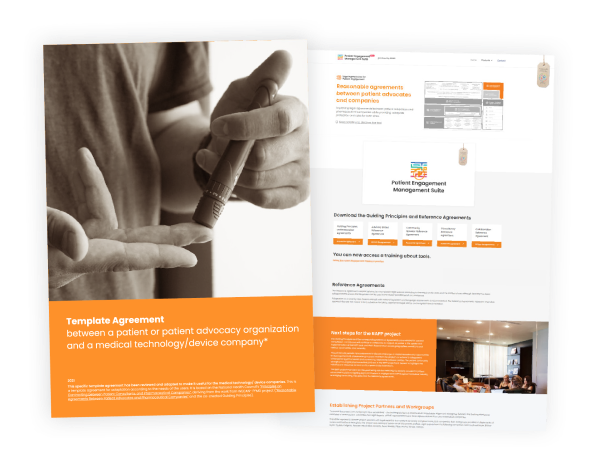Starting a patient engagement initiative in medicines and device development?
Creating a reasonable legal agreement from scratch between patient advocates and industry can be challenging.
You can now use co-created guiding principles for the development of reasonable legal agreements and contract templates, as well as a toolbox for patient advocates and companies.
In some cases, your legal work doesn’t have to start from scratch.
Explore the reference agreements available for you
Ensure your engagements are aligned with National Codes of Conduct
Navigating Country Codes of Conduct and other regulation that impact interactions between pharmaceutical companies and the patient community can be an overwhelming task. The Patient Engagement (PE) Guidelines provide a quick reference to point you in the right direction!
Managing competing interests and conflicts of interest is of utmost importance when planning, considering and conducting patient engagement activities in medicines development.
You can now access a set of co-created tools to help manage competing interests and conflicts of interests.
If you are intrigued by these guiding principles or reference agreements but want to better understand them first, an interactive version including extra explanations, in-depth descriptions for the terminology, clauses, sections and a rationale to each agreement is available.
PE Country Guidelines
All the PEM Suite tools are designed to work together.
Interested to learn more about patient engagement?
How were these tools developed
Reasonable agreements between patient advocates and pharmaceutical companies (RAPP)
This patient-driven multi-stakeholder project was led by Workgroup of European Cancer Patient Advocacy Networks (WECAN), coordinated by Myeloma Patients Europe (MPE) in collaboration with Patient Focused Medicines Development (PFMD) and independent participation of over 10 pharmaceutical companies respectively.

Legal agreements explained
The need for a legal framework within which collaboration between pharmaceutical industry and patients can happen in a mutually respectful way was identified by PARADIGM as part of its gap analysis on patient engagement tools and practices.
To address this need, the co-created Guiding principles and reference agreements from the RAPP project were tested and discussed at the Patient Engagement Open Forum in 2019 with a conclusion that something additional was needed to make them more user-friendly and practical to the patient community.
The partners agreed to collaborate and co-create a digital tool, which provides more in-depth descriptions for the terminology, clauses, sections and a rationale to each agreement.
The National Health Council adapted co-created reference contracts from the RAPP-project to the US context. This was reviewed and aligned for the US medtech sector.
Conflict of interest
The process of creating this tool started with a comprehensive methodology including a non-systematic literature search, followed by forming a balanced authoring group. Efforts were made to include legal and compliance industry representatives, patient representatives with legal background and with personal experience on the topic of conflict of interest.
Representatives from the European Medicines Agency also contributed to content development and document review.
A dedicated workshop focused on getting additional feedback. The documents underwent a second consultation with the PARADIGM consortium and the PILG and a public consultation.
Subscribe to get the latest updates
The “Patient Engagement Management Suite” is brought to you by the PFMD partnership.
